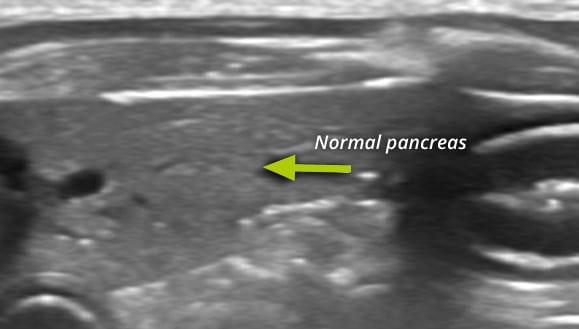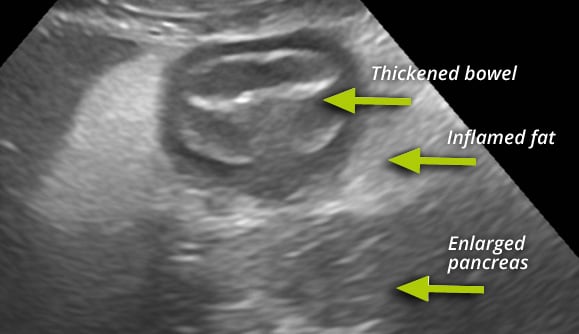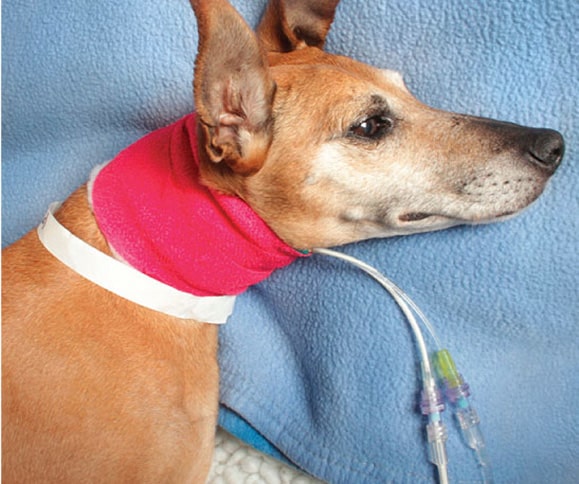
What is pancreatitis?
The pancreas is an organ in the abdomen (tummy) which is responsible for releasing enzymes (types of proteins) to digest food. The pancreas also releases important hormones (such as insulin) into the bloodstream.
Pancreatitis occurs when the pancreas becomes inflamed (tender and swollen). In most cases pancreatitis occurs for no apparent underlying reason, although sometimes it can have a particular cause (such as scavenging food). Pancreatitis most commonly affects middle aged to older dogs, but in addition, dogs of certain breeds (e.g. Cocker Spaniels and Terrier breeds) are more prone to developing the condition.
What are the signs of pancreatitis?
Pancreatitis can cause a variety of symptoms, ranging from relatively mild signs (e.g. a reduced appetite) to very severe illness (e.g. multiple organ failure). The most common symptoms of pancreatitis include lethargy, loss of appetite, vomiting, abdominal pain (highlighted by restlessness and discomfort), diarrhoea and possibly jaundice.
How is pancreatitis diagnosed?
The possibility that a dog may be suffering from pancreatitis is generally suspected on the basis of the history (i.e. loss of appetite, vomiting, etc.) and the finding of abdominal pain on examination by the veterinary surgeon. Because many other diseases can cause these symptoms, both blood tests and an ultrasound scan of the abdomen are necessary to rule out other conditions and to reach a diagnosis of pancreatitis. Although routine blood tests can lead to a suspicion of pancreatitis, a specific blood test (called ‘canine pancreatic lipase’) needs to be performed to more fully support the diagnosis. An ultrasound scan is very important in making a diagnosis of pancreatitis. In addition, an ultrasound scan can also reveal some potential complications associated with pancreatitis (e.g. blockage of the bile duct from the liver as it runs through the pancreas).

The normal canine pancreas. It is a similar shade of grey to the surrounding fat.

A dog with pancreatitis. The pancreas is darker than normal and enlarged. The surrounding fat is brighter than normal and the intestine (seen in cross section) is also thickened.
How is pancreatitis treated?
There is no specific cure for pancreatitis, but fortunately most dogs recover with appropriate supportive treatment. Supportive measures include giving an intravenous drip (to provide the body with necessary fluid and salts) and the use of medications which combat nausea and pain. Most dogs with pancreatitis need to be hospitalised to provide treatment and to undertake necessary monitoring, but patients can sometimes be managed with medication at home if the signs are not particularly severe. At the other extreme, dogs that are very severely affected by pancreatitis need to be given intensive care, ideally in a high dependency care unit such as the one we have at NDSR.
One of the most important aspects of treating pancreatitis is to ensure that the patient receives sufficient appropriate nutrition while the condition is brought under control. This can be very difficult, because pancreatitis causes a loss of appetite. In this situation it may be necessary to place a feeding tube which is passed into the stomach, and through which nutrition can be provided (see Information Sheet on Feeding Tubes). If a dog with pancreatitis is not eating and will not tolerate a feeding tube (e.g. due to vomiting), intravenous feeding (using a drip to supply specially formulated nutrients straight into the bloodstream) may be necessary.

A patient undergoing intravenous feeding
What is the outcome in pancreatitis?
It may be necessary for dogs with pancreatitis to be hospitalised for several days, but fortunately most patients with the condition go on to make a complete recovery, provided that appropriate veterinary and nursing care is provided. In some instances, dogs can suffer repeated bouts of the condition (called ‘chronic pancreatitis’) and this may require long term management with dietary manipulation and other approaches which the specialist will discuss with you in detail, as required.
Why should I bring my pet to NDSR for investigation and treatment of pancreatitis?
Our medicine service is led by a team of recognised, accredited Specialists and we aim to provide the best possible care and treatment for your pet in our state-of-the-art hospital. Our medicine team works closely with the imaging Specialists who run NDSR’s sophisticated imaging facilities, as well as with expert anaesthesia and analgesia Specialists and 24-hour veterinary and nursing staff, all of whom help to optimise the potential for our patients to make a full and uneventful recovery. We have extensive experience of managing critically ill patients, often with complex medical complaints.
If you have any queries or concerns, please do not hesitate to contact us.
Arranging a referral for your pet
If you would like to refer your pet to see one of our Specialists please visit our Arranging a Referral page.